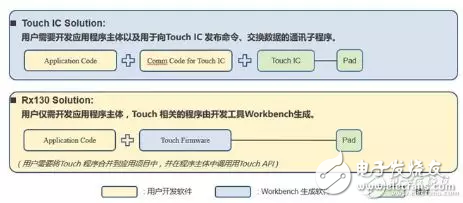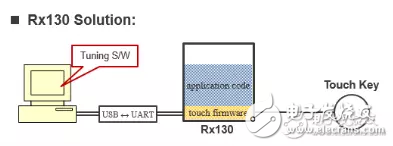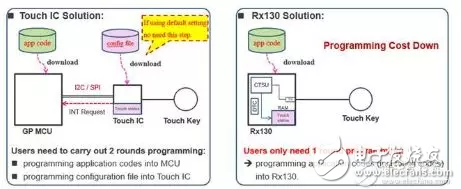First introduce what is MCU? MCU Microcontroller Unit (MCU), also known as Single Chip Microcomputer (Single Chip Microcomputer) or Single Chip Microcomputer, is to appropriately reduce the frequency and specifications of the Central Process Unit (CPU), and reduce the memory (memory ), Counter (Timer), USB, A/D conversion, UART, PLC, DMA and other peripheral interfaces, and even LCD driving circuit are integrated on a single chip to form a chip-level computer, which can be used for different combinations of control for different applications. Such as mobile phones, PC peripherals, remote controllers, to automotive electronics, industrial stepping motors, robotic arm control, etc., you can see the MCU.
Touch ic touch here specifically refers to single-point or multi-point touch technology; IC, that is, integrated circuit, is a general term for semiconductor component products. Including: 1. integrated circuit (abbreviation: IC); 2. two and triode; 3. special electronic components, etc.; touch IC refers to touch chip.
1. The workload and difficulty of debugging for the first time establishing a touch applicationCompare the differences between the two from the workload and debugging difficulty of first creating a touch application. Use the schematic diagram of the software and hardware components in the touch IC and touch MCU application scheme, as shown in Figure 1.

Figure 1 Software and hardware composition diagram of the application scheme using touch IC and MCU
In the application scheme using the touch IC, the data exchange between the master MCU and the touch IC is usually realized through a serial interface (for example, I2C, SPI).
Therefore, users need to develop corresponding communication programs to perform data exchange. Whether it is using the hardware serial interface of the master MCU or using software to simulate the serial protocol to realize data transmission, it increases the load of software development.
Especially in the early stage of debugging, if the main control MCU cannot correctly detect the touch action, it is necessary to determine whether the source of the fault is an abnormal touch IC, or an abnormal communication program, or an error in the main control MCU side detection program. Therefore, the difficulty of software debugging is greatly increased.

Figure 2 Optimize the working environment of touch IC
2. Refined touch parametersFrom the perspective of refinement of touch parameters (for example, sensitivity), compare the differences between the two. The touch IC usually has built-in default parameters. If the detection program and communication program of the master MCU are correct, then after the MCU and the touch IC are connected, it can be judged whether there is a touch or not.
From this point of view, the touch IC has advantages. However, the default parameters are determined, and the user's application scheme is very different. Therefore, in many cases, it is necessary to fine-tune the touch parameters to optimize the touch performance of the application solution. The working environment of the optimized touch IC is shown in Figure 2.
As shown in Figure 2, Tuning software uses a serial interface to adjust the touch parameters, and writes the optimized parameters to the touch IC through the serial interface.
In order to verify the overall performance of the updated parameters in the application system, it is necessary to connect the main control MCU and the touch IC, and run the control program in the MCU.
However, the debugging tool and the master MCU share the serial interface of the touch IC. Therefore, it is necessary to cut off the connection with the debugging tool and switch the serial interface to the master MCU.
In other words, when verifying the overall performance of the parameters, the GUI of the debugging tool cannot be used to visually monitor the effects of parameter adjustments.

Figure 3 Adjust the environment of Rx130 application scheme
3. The cost of programming
Figure 4 Touch IC solution and Rx130 solution program burning
From the cost of programming, compare the differences between the two. As shown in Figure 4, if the user does not use the default parameters of the touch IC, but uses the parameters optimized in conjunction with the specific application scheme, the latest parameters need to be solidified to the touch IC through the programmer.
Especially during mass production, the additional cost of programming the touch IC is increased. In the Rx130 solution shown on the right, only the application program needs to be burned into the Rx130.
4. LED driverFrom the perspective of LED drive, compare the similarities and differences between the two. Usually, the touch IC has a built-in LED Driver. If the application scheme needs to use LED to indicate the presence/absence of touch action, and the structural design of the application product requires the LED to be close to the touch electrode, as shown in Figure 5, it is more convenient to use the touch IC to lay out the PCB.

Figure 5 Touch IC is more convenient for PCB layout
However, not all application products need to use LEDs to indicate the presence/absence of touch actions, such as simple touch pads.
Other capacitors
Other Capacitors,Ac Filter Capacitor,Power Saver Capacitor,Line Filter Capacitor,Low Voltage Capacitor
YANGZHOU POSITIONING TECH CO., LTD. , https://www.yzpst.com